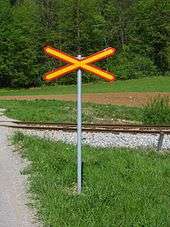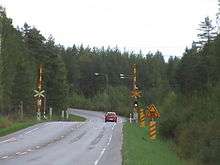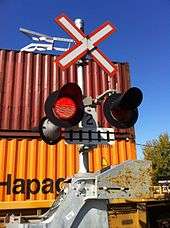Level crossing
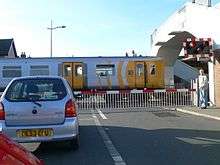
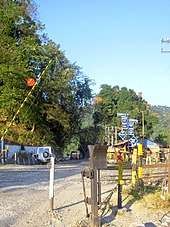
A level crossing is an intersection where a railway line crosses a road or path at the same level,[1] as opposed to the railway line crossing over or under using an overpass or tunnel. The term also applies when a light rail line with separate right-of-way or reserved track crosses a road in the same fashion. Other names include railway level crossing,[1] grade crossing, road through railroad, railroad crossing, train crossing, and RXR (abbreviated).
History
The history of level crossings depends on the location, but often early level crossings had a flagman in a nearby booth who would, on the approach of a train, wave a red flag or lantern to stop all traffic and clear the tracks. Gated crossings became commonplace in many areas, as they protected the railway from people trespassing and livestock, and they protected the users of the crossing when closed by the signalman/gateman. In the second quarter of the 20th century, manual or electrical closable gates that barricaded the roadway started to be introduced, intended to be a complete barrier against intrusion of any road traffic onto the railway. Automatic crossings are now commonplace in some countries as motor vehicles replaced horse-drawn vehicles and the need for animal protection diminished with time. Full, half or no barrier crossings superseded gated crossings, although crossings of older types can still be found in places. In rural regions with sparse traffic, the least expensive type of level crossing to operate is one without flagmen or gates, with only a warning sign posted. This type has been common across North America and in many developing countries.
Some international rules have helped to harmonize level crossing. For instance, the 1968 Vienne convention about signalisation routière:
- In its Chapitre III Signaux lumineux de circulation: Article 23b states that one or two blinking red fire indicates a car should stop; when if they are yellow the car can pass with caution.[2]
This has been implemented in many countries, including countries which are not part of the Vienna Convention.
- In its article 27, a stop line is suggested at grade crossing.
- Article 33, 34, 35 and 36 are specific to level crossing, because level crossing are recognized as dangerous.
- Article 35 indicates a cross should exist when there is no barrier.
Safety

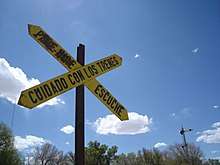
Trains have a much larger mass relative to their braking capability, and thus a far longer braking distance than road vehicles. With rare exceptions, trains do not stop at level crossings and rely on vehicles and pedestrians to clear the tracks in advance.
Level crossings constitute a significant safety concern internationally. On average, each year around 400 people in the European Union[3] and over 300 in the United States[4] are killed in level crossing accidents. Collisions can occur with vehicles as well as pedestrians; pedestrian collisions are more likely to result in a fatality.[5] Among pedestrians, young people (5–19 years), older people (60 years and over) and males are considered to be high risk users.[6]
As far as warning systems for road users are concerned, level crossings either have "passive" protection, in the form of various types of warning signs, or "active" protection, using automatic warning devices such as flashing lights, warning sounds, and barriers or gates.[3] In the 19th century and for much of the 20th, a written sign warning "Stop, look, and listen" (or similar wording) was the sole protection at most level crossings. Today, active protection is widely available, and fewer collisions take place at level crossings with active warning systems.[7] Modern radar sensor systems can detect if level crossings are free of obstructions as trains approach. These improve safety by not lowering crossing barriers that may trap vehicles or pedestrians on the tracks, while signalling trains to brake until the obstruction clears (however, they cannot prevent a vehicle from moving out onto the track once it's far too late for the locomotive to slow even slightly).[8]
At railway stations, a pedestrian level crossing is sometimes provided to allow passengers to reach other platforms in the absence of an underpass or bridge, or for disabled access. Where third rail systems have level crossings, there is a gap in the third rail over the level crossing, but this does not interrupt the power supply to trains since they have current collectors on multiple cars.
| United States | Europe |
|---|---|
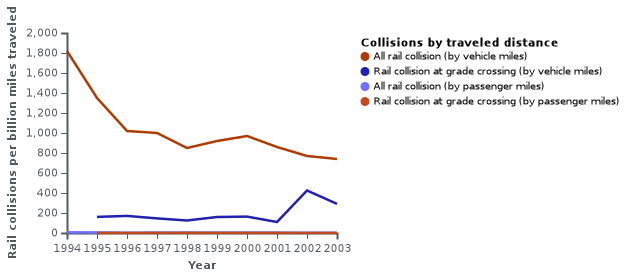 |
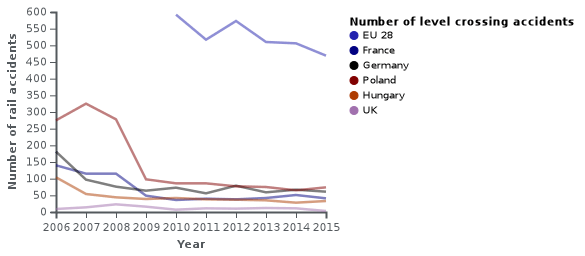 |
| * Source, left: transit.dot.gov, US Department Of Transport.[9] (1 international mile=1 609.344 meters) | * Source, right: Eurostat: The rail accident data are provided to Eurostat by the European Railway Agency (ERA). The ERA manages and is responsible for the entire data collection. The Eurostat data constitute a part of the data collected by ERA and are part of the so-called Common Safety Indicators (CSIs).
Note: Since 2010, use of national definitions is no longer permitted: 2010 CSI data represent the first fully harmonized set of figures |
| Europe | |
|---|---|
 | |
| * Source, right: Eurostat: Annual number of victims by type of accident [rail_ac_catvict] Last update: 09-02-2017 |
Traffic signal preemption
Traffic signal-controlled intersections next to level crossings on at least one of the roads in the intersection usually feature traffic signal preemption.[10] Approaching trains activate a routine where, before the train signals and gates are activated, all traffic signal phases go to red, except for the signal immediately after the train crossing, which turns green (or flashing yellow) to allow traffic on the tracks to clear (in some cases, there are auxiliary traffic signals prior to the railroad crossing which will turn red, keeping new traffic from crossing the tracks. This is in addition to the flashing lights on the crossing gates). After enough time to clear the crossing, the signal will turn. The crossing lights may begin flashing and the gates lower immediately, or this might be delayed until after the traffic light turns red.
The operation of a traffic signal, while a train is present, may differ from municipality to municipality. In some areas, all directions will flash red, turning the intersection into an all-way stop. In other areas, the traffic parallel to the railroad track will have a flashing yellow for the duration of the train while the other directions face a flashing red light for the duration of the train. Still in other areas, the traffic parallel to the railroad track will have a green light for the duration of the train while the other directions face a red light for the duration of the train. Further still in other areas can traffic lights operate relatively normally with only the blocked direction turning red for the duration of the train.
Crossings around the world
Europe
In European union (including UK), 47% are passive (unprotected) level crossings and 53% are active (protected) level crossings.[11] Level crossing fatalities are 28% of railway fatalities.
Albania
Albanian level crossings are uncommon, but do have red lights and barriers that may be automatic. Many crossings are still manual, but some are automatic and have bells. There are not many crossings in Albania.
Austria
Austrian level crossings are similar to German crossings, in that they have either a single or double light with automatic barriers that lower when a train approaches. The crossings with two lights (one amber, one red) are the more modern, replacing old single red light crossings.
Belgium
Automatic level crossings in Belgium have two red lights, a "moon-white" light, electronic (previously mechanical) bells and (usually) barriers. The white light flashes for half a second at regular intervals to inform drivers and pedestrians that they can cross the level crossing, and that the signal is in working order. In some cases the white light is absent; the Belgian traffic law of 1975 does not cover that situation. The bells ring until the barriers are fully lowered and then stop. If barriers are absent the bell continues ringing throughout.
At a level crossing, any overhead electric power cables must also cross. This led to a conflict where a mainline railway that crossed one of the country's once extensive interurban tram lines (vicinal, buurtspoorweg/vicinaux) was electrified. In at least one location, this led to the tram overhead being dismantled.
Bulgaria
A level crossing in Bulgaria usually has two red lights and a flashing white light, similar to Belgian crossings. Automatic barriers protect the crossing and the white light informs of correct operation, although older crossings omit the white light.
Croatia
Croatian level crossings are similar to Slovenian crossings in that the lights are composed of red lights in a triangle. Many crossings are automatic with barriers and bells.
Czech Republic/Slovakia
Level crossings in Czech Republic and Slovakia use a sign on the lights that reads "Pozor Vlak" (Attention - Train) to warn people of the crossing. The lights are similar to the Belgian crossings in that they have two red lights and sometimes a white light, which means the driver can go up to 50km/h, rather than 30km/h, with half barriers. On some crossings, the space for a white light is provided but no light is there, because in newer legislation it is taken as dangerous element that should not be used to positively change drivers' speed. Usually a yellow outline surrounds the crossbucks for increased visibility at night.
Estonia
A level crossing with two red lights and polish barriers and bells. Ungated or gated designs. There are currently half barriers or full barrier gated crossings.
Finland
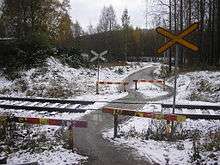
In Finland, level crossings with warning lights have the more common red light(s) and a white light that flashes except when the red light(s) flash. Most, but not all, crossings with lights also have barriers. Full-length barriers are usually used only for pedestrian and bicycle lanes. Half-length barriers are used for motor roads, to avoid the risk of a vehicle being trapped on the tracks between the barriers. Bells begin to ring when the red lights start flashing and usually stop when the barriers have come down. Red-and-yellow crossbucks are used on both controlled and uncontrolled level crossings. If there are two or more tracks, the lower part of the cross is doubled. Only minor agricultural crossings may have no signs at all. On bigger roads there are usually also approach signs as seen in the picture. Finnish level crossings are the sixth safest in Europe.[12] Finland's state railway system has almost 3000 level crossings, according to TraFi.[13] In Finland over the course of railway history many level crossing accidents have occurred, in comparison to Scandinavian countries.[14] In Finland the maximum speed for trains on the rails with level crossings is 140 km/h.[15]
France
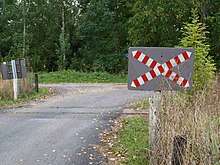
French level crossings usually have a single red light on a circle backboard, bells and automatic half barriers. When activated, the red light flashes, the bells ring, and the barriers come down. French level crossings with more than one track have a sign saying "un train peut en cacher un autre" (a train can hide another train).
As of 2016 France has 15,459 level crossings (by comparison, there were 33,500 in 1938 and 25,000 in 1980). Of these, less than 0.4% are on national roads, 31.4% are on departmental roads and 68.2% are on town roads.[16] The high-speed train lines are built with no level crossings, but high-speed trains are also used on classical railway lines and exposed there to level crossing accidents.
154 out of 15459 level crossings are registered in a national program to make level crossings more secure.
In 2015, 100 crashes occurred at French level crossings, causing 26 fatalities.[17] These crashes are usually caused by imprudence, e.g., trying to pass as the barriers are down or are closing, in violation of the French traffic code.
Germany
German crossings use yellow and red lights and a bell/alarm (some crossings do not have these though) to indicate that the crossing is active. When activating a preliminary yellow light flashes which is followed by a red light that stays lit until the crossing has been cleared by the incoming train. Most of these crossings usually have a lightning symbol on the crossbucks. These symbols indicate that the railway is electrified with overhead wires. Older crossings have a single red light on a square backboard with a red and white border. One older crossings, if more than one train is coming, the bell will change in tone and a sign reading "2 Züge" will flash.
Greece
There are loads of types of these in Greece, even a Czech railroad crossing! Most have two lights, Some have American bells and other have German barriers. One to four track included. These are some strange crossings for Greece. It is due to poor economy debt from the EU causing these type of crossings and even tracks are sometimes overgrown!
Hungary
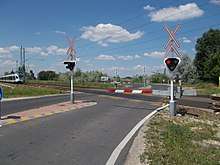
In Hungary, level crossings mostly do not have audible tones, and some also do not have lights. Full barriers usually don't have lights, but have an audible warning. Crossings equipped with lights are common. The newest, and best solution is a crossing equipped with half-barriers and LED-lights. A unique type of level crossings in Hungary have a sign saying "10 percen túl is zárva tartható" (can be kept closed for more than 10 minutes).
Ireland
Irish level crossings are similar to UK level crossings, in that they have a preliminary amber light before the red lights start flashing and the barriers descend (one example at Wexford does not have an amber light). Crossings are the same on the whole island of Ireland, and are either of the old gated variant, or are automatic. Ireland does have automatic crossings that have full barriers, which are not seen in the UK. The audible alarms are unique to the country.
Italy
Level crossings in Italy, much as in the rest of Europe, can be manned, unmanned, manual, or automated. In the Italian highway code, level crossings are called Passaggi a Livello, often abbreviated to "P/L" on vertical and horizontal road signage. Some level crossings have a sign saying "stop con segnale rosso" (stop with red signal). The crossing can be composed of single or double red lights, mechanical or electrical barriers and sometimes a rotating crossbuck.
Moldova
Moldova's level crossings are very similar to Russian level crossings, with the two red lights, but, like the Romanian level crossings, have an intermittent white light that flashes when there are no trains approaching. The bells are very loud, just like Russian bells.
Montenegro
A railroad crossing with a red border and yellow in the middle with two lights at the bottom. Gated or ungated crossing. Some may have just an X on them while the others with the lights have an X and a bell. It comes with a height restriction aswell because it is electrified. The others on casual line without overhead wires do not come with these
Netherlands
Most level crossings have half barriers, mechanical or electrical bells, and double (or sometimes single) red lights. The lights flash alternately, as do the ones on the barriers. Those for pedestrians with an active warning system have full barriers. Three level crossings are operated remotely by staff from a traffic control center, using cameras; these have full barriers and no bells. Two level crossings for vehicles have full barriers, with a system to detect a vehicle which has been trapped; in this case the exit barriers are opened. Crossings with little road traffic and/or little rail traffic have no alarm, just warning signs. There are no level crossings where trains routinely run at over 140 km/h. Level crossings have a sign saying "WACHT" (WAIT).
Warning lights and bells are activated when the train is about 1 km before the crossing, depending on line speed. 5 seconds later the barriers start closing, which takes about 10 seconds. When the barriers have closed, the bells are often set less loud. Lights and bells are stopped when the barriers have raised again. As passive warning signs there are red and white striped fences, red and white saltires for single tracks (doubled in case of two or more tracks) and sometimes advanced warning signs at 80, 160 and 240 metres.
When there is a station shortly before the level crossing and an intervening signal, the signal may remain red and the crossing kept open until the train approaches the station. The crossing would then close after a delay, allowing the signal to be cleared.
Norway
In Norway, level crossings have red and white crosses with a similar light system to German crossings, although the yellow light shines and then the single red light flashes, as do the lights on the barriers.
From 1998-2008 the Norwegian rail administration (Jernbaneverket) removed about 1000 level crossings, leaving about 3500 still in use. 160 kilometres per hour (99 mph) is the maximum speed for trains over level crossings.[18] In addition, Oslo's and Bergen's tram or light rail systems have some level crossings. Most lines on Oslo's metro (T-banen) are free of them. Most of the level crossings were removed from the old suburban railways in the western parts of the city, when the lines were upgraded to metro standard, but some crossings are retained on the Holmenkollen Line.
Portugal
Portugal's level crossings have bells, but most do not have lights. Two alternating flashing lights accompany the barriers, which can be manual or automatic. They also have a sign saying "pare ao sinal vermelho" (stop at the red light). When activated, the bells ring, the lights flash, the barriers come down and the bells continue to ring.
Romania
Romania's level crossings have a light pattern similar to the Czech Republic and Russia, but the lights have a different appearance. The sequence is the same with the alternating red flashing lights and the intermittent white light that flashes when no trains are approaching.
Russia
Russia's level crossings have one of the loudest bells. Like U.S. level crossings, Russia has two red lights. It acts similarly to U.S. level crossings, but the barriers go slightly up for one second before going down.
Serbia
Serbian level crossings have red triangles with a yellow inside, and two red lights in the triangle. Alarms sound, the barriers come down and the lights flash when a train approaches. The crossing barriers and crossbucks are red and yellow.
Slovenia
In Slovenia, level crossings are similar to Swiss crossings, in that they have a normal warning sign triangle but with two red lights inside it. The crossings have half barriers (mainly) and alarms that sound when a train approaches.
Spain
Spanish level crossings have two alternating red lights and sometimes a pedestrian light on the other side of the crossing. When activated, the lights flash, the bells ring and the barriers lower, as the crossing is usually automatic. More rarely, once the barriers have fully lowered, the sound changes. For some level crossings, when the barriers begin to go up, the square light stops flashing. More often, the level crossings in Spain, unlike all other level crossings, activate a long time before the train arrives.
Sweden
In Sweden there are 8,500 level crossings, according to Trafikverket, the Swedish Transport Administration (former Banverket, Swedish Rail Administration). On public roads they have light signals with or without gates. On private roads there are level crossings without signals. Most accidents occur on crossings without gates. For many years there have been activities to reduce the number of accidents, usually by adding gates, or adding light signals if there were none. On the main lines many bridges have been built, and also anywhere a new road or new railway has been built. Still there are some level crossings left on the main lines. A train speed of 200 km/h is allowed in Sweden over level crossings, if there are gates and an obstacle detection unit. This unit detects cars on the track and prevents the gates from closing fully and stops the train. According to Trafikverket, in 15 years there has only been one serious collision between a car and a train on such a level crossing, when a car ran through the gates just in front of the train. Level crossings have a power line with a sign saying "livsfarlig ledning" (dangerous conduit). Some also have a sign saying "se upp för tåg" (beware of trains).[19]
Switzerland
Most level crossings in Switzerland have two red lights on the bottom of a triangle backboard, bells, barriers, and more rarely, another triangle with one red light in the middle. When activated, each red light flashes for a third of a second. The bells ring as well. After a few seconds, the barriers come down and the bells stop ringing. Most Swiss crossings are automatic and a few are also on rack railway systems, so they have rising teeth that come out from the ground.
Turkey
Turkish level crossings have two red lights, alarms, barriers and a single red light displaying "DUR" (stop).
Ukraine
Level crossings in Ukraine can consist of two red lights and possibly a white light to indicate the crossing is in working order. Barriers can also be included, as well as a vast array of noises that accompany the closure.
United Kingdom
.jpg)
Level crossings in the United Kingdom started out as manually gated crossings opened by a signalman. These were standard all across the network until mechanised barriers started to be introduced. These could be operated by a signalman adjacent to the crossing or were automatic. After the major Hixon rail crash in 1968, the design of level crossings started to change, and all mechanised crossings had to have a preliminary amber light fitted, which makes UK level crossings one of only a few countries with this design of crossing. More recent advantages in technology have led to more technical automatic crossings, more safer open crossings, and crossings with obstacle detection systems to detect stray people or vehicles on the crossing. Nevertheless, level crossings were the location of 54 collisions between trains and road vehicles between 2011 and 2018.[20]
The nearly seven and a half thousand level crossings in the United Kingdom[21] can be broadly classified into two types: protected crossings - consisting of warning lights and gates or barriers which prevent crossing when a train is nearby; and unprotected crossings - footpaths, bridleways and user-worked crossing (where the responsibility for ensuring a safe crossing lies on the user).[22] Network Rail, responsible for maintaining most of the crossings, is taking steps to reduce safety risks,[23] for example by closing crossings where possible.[24]
North America
Canada
Grade crossings in Canada are required by law to be marked by a crossbuck with alternating flashing red lights and gate arms. Crossbuck signs are white with a red outline and, if the situation warrants, contain a supplemental sign to indicate the number of tracks. The advance-warning sign, which is a yellow diamond shape with a diagram of a track crossing a straight segment of road (similar to a crossroads sign, except that the horizontal road is replaced by a track). Before changes in regulations mandated bilingual (English and French) or wordless signs, either "Railway Crossing" or "Traverse de Chemin de fer" were written on crossbucks.
Mexico
Mexico has also begun to install US-style crossing signals on some of its KCS de Mexico, Ferromex, and Ferrosur rail lines; however, the majority of rail crossings in Mexico remain unsignalled, marked only with a crossbuck. The crossing devices are very similar to the US models, sporting larger lights. The crossbucks read "Cruce de ferrocarril", "Crucero ferrocarril", or "Cuidado con el tren". The majority of crossings are solar operated, and the lights flash faster than the US signals. Unfortunately, these devices are easy targets for vandals as they steal their components such as gate motors and solar panels. In many cases the gates do not lower due to vandalism or lack of maintenance. In some cases due to the lack of maintenance, the lights do not turn on at all. The rail companies, which by law are required to maintain the crossing signals, take little to no action in maintaining these devices, and the majority remain unmaintained, posing a threat to drivers.
United States
The first US patent for manual/electrical crossing gates was awarded on 27 August 1867, to J. Nason and J. F. Wilson, both of Boston.[25]
Crossing identification
Every crossing, whether above grade, below grade, or at grade, is required to be assigned a unique identifier which is a six-digit number and a trailing letter used as a checksum. This identifier is called a Grade Crossing Number, and is usually posted with a sign or sticker on the sign or equipment. This allows a particular crossing anywhere in the United States to be precisely identified as to its exact location in the event of an incident involving that crossing.
Traffic control devices
All public crossings in the United States are required to be marked by at least a crossbuck. The 2009 Manual on Uniform Traffic Control Devices requires passive crossings (crossings without actuated flashing lights or gates) to have either stop signs or yield signs in addition to the crossbuck, unless a flagger will stop traffic every time a train approaches. Normally a yield sign is used, unless it is determined that all vehicles should stop at the crossing, such as a location with poor sight distance.[26] All passive crossings must be upgraded to meet this standard by 31 December 2019.[27]
If the crossing has more than one railroad track, the crossbuck is required to have a small sign beneath it denoting the number of tracks.
As traffic on the road crossing or the rail crossing increases, safety features are increased accordingly. More heavily trafficked crossings have "automatic warning devices" (AWDs), with alternately flashing red lights to warn automobile drivers and a bell to warn pedestrians. Additional safety is attained through crossing gates that block automobiles' approach to the tracks when activated. Increasingly, crossings are being fitted with four-quadrant gates to prevent circumventing the gates.

Operation of a typical AWD-equipped railroad crossing in the United States is as follows:
- About 30 seconds before arriving at the crossing, the train trips a track circuit near the crossing, triggering the crossing signals. The lights begin to flash alternately, and a bell (or bells) mounted at the crossing begins ringing. After several seconds of flashing lights and ringing bells, the crossing gates (if equipped) begin to lower, which usually takes 5–10 seconds. Some AWDs silence the bell once the gates are fully lowered (typically seen on most Norfolk Southern and CSX crossings); most continue ringing the bells throughout (Union Pacific, BNSF Railway). Some crossings will not sound the bell at all after dark in the case that it is installed near a residential area. The lights continue to flash throughout regardless.
- About 15–20 seconds before arriving at the crossing, the train begins ringing its bell and sounding its horn in accordance with NORAC rule 14L or GCOR rule 5.8.2(7): two longs, one short, and one long. These are prolonged or repeated until the engine occupies the crossing. If the AWD is equipped with a wayside horn in accordance with FRA Quiet Zone rules, the AWD may provide the whistle signal instead of the train; however, the train is required to ring its bell regardless.
- After the train has cleared the crossing, the bells (if silenced) may begin ringing again (such as the Florida East Coast Railway), and the gates (if equipped) begin to rise. Once the gates have completely risen back to their fully raised position, all warning signals, including the lights and bells, are suppressed.
Some AWD track circuits are equipped with motion detectors that deactivate the crossing signal if the train stops or slows significantly before arriving at the crossing.
As indicated above, the pattern of the bells at each individual crossing can be different. (These bells should not be confused with the bells that are mounted on the trains.) Generally, the bells follow one of these patterns:
- The bell begins ringing when the lights begin flashing and stops when the gates have completely lowered.
- The bell begins ringing when the lights begin flashing and stops when the gates begin to go up following the passing of the train.
- The bell begins ringing when the lights begin flashing and stops when the gates have completely lowered, and then resumes ringing when the gates begin to go up, until the gates have returned to their original position.
- The final, and most common, practice is for the bells to begin ringing when the lights begin flashing and continue until the gates have gone up after the train passes.
Some level crossings that are located close to intersections with traffic lights program the signals with a preemption sequence so when the approaching train trips the track circuit, it not only activates the crossing signals, but also changes the traffic lights facing the crossing to green, to clear any traffic that may be queued on the crossing. If the intersection's stop line is right before the tracks (typically sharing the crossing's stop line), the track circuits would change the traffic lights to red (often without a yellow phase). Some track circuits place the signals into flash mode the entire time the AWDs are active. In cases where railroads share the right of way with vehicular traffic, simple railroad preemption may cause an all-red flash in traffic lights.[28]
A few level crossings still use wigwag signals, which were developed in the early 1900s by the Pacific Electric Railway interurban system in the Los Angeles region to protect its many level crossings. Though now considered to be antique, around 100 such signals are still in use, almost all on branch lines. By law, these signals must be replaced by the now-standard alternating red lights when they are retired.
US Federal Railroad Administration regulations restrict trains to a maximum speed of 110 mph (177 km/h) at standard grade crossings. Crossings are permitted up to 125 mph (201 km/h) only if an "impenetrable barrier" is in place to block traffic when a train approaches. Crossings are prohibited at speeds in excess of 125 mph (201 km/h).[29]
A track that will run high-speed trains in excess of 120 miles per hour (190 km/h) is being tested in Illinois between Chicago and St. Louis, Missouri. Here, due to the high speed of the trains, gates that totally prevent road traffic from reaching the tracks are mandatory on all level crossings. Steel mesh nets were tested on some crossings to further prevent collisions, but these were removed because of maintenance issues in 2001.
A new device called "StopGate" has been installed at four locations, one in Madison, Wisconsin; another in Monroe, Wisconsin and two in Santa Clara, California (on a light rail system). This system resembles a fortified version of a standard crossing gate, with two larger arms blocking the entire width of the roadway and locking into a securing device on the side of the road opposite the gate pivot mechanism. The gate arms are reinforced with high-strength steel cable, which helps the gate absorb the impact of a vehicle attempting to crash through the gate. The manufacturer claims that the StopGate can stop a 2,000 kilograms (4,400 lb) truck within 13 feet (4.0 m). The system has been tested at the Madison crossing, when the system stopped a truck while a Wisconsin and Southern Railroad train was in the crossing.
Another new type of barrier is being tested in Michigan that is hoped to reduce the number of times drivers attempt to drive around lowered crossing gates. The new devices are called "delineators" consisting of a series of flexible bollards that raise vertically out of vertical tubes in the pavement when the crossing signal is activated. The delineators are designed so that they will not be broken and will not damage vehicles if they are hit, allowing vehicles to exit the level crossing if they are already within it when the gates are activated. The test period for the new barrier began on 5 December 2007, and ran for at least 17 months.[30][31]
Locomotive equipment
In the United States and in countries following United States practices, a locomotive must have a bright headlight and ditch lights (two lights located below the headlight), a working bell, and a whistle or horn that must be sounded four times (long-long-short-long), similar to the signal for the International Morse Code letter "Q", as the train approaches the crossing.
Some American cities, in the interest of noise abatement, have passed laws prohibiting the sounding of bells and whistles. In December 2003 the US Federal Railroad Administration published regulations that would create areas where train horns could be silenced, provided that certain safety measures were put in place, such as concrete barriers preventing drivers from circumventing the gates or automatic whistles (also called wayside horns) mounted at the crossing (which reduce noise pollution to nearby neighborhoods). Implementation of the new "Quiet Zone" Final Rule was delayed repeatedly but was finally implemented in the summer of 2005. Rail "Quiet Zone" crossings still require bells as part of the AWDs in addition to the wayside horns. Wayside horns are sets of speakers that are mounted on a pole and directed at the crossing. They produce sounds similar to a train horn.
Central America
Costa Rica

INCOFER has crossings with crossbucks as in the photo, with the words "Cuidado con el tren" (be careful of the train), as well as crossbucks without lettering, and a normal stop sign (alto). Since most crossings don't have automatic gates, the train has to blow the horn. Some crossings have warning lights.
El Salvador
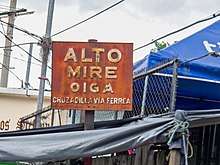
If marked at all, the railroad crossing will have a sign marking it. This sign says, "Alto, Mire, Oiga" (Stop, Look, Listen). There are no gates.
Asia
Level crossings in Thailand, and Malaysia are largely manually operated, where the barriers are lowered using a manual switch when trains approach. A significant number of crossings are without barriers. Railway electrification in Malaysia has gradually eliminated level crossings in Peninsular Malaysia, replacing those along nearly all upgraded lines with large overhead viaducts or deep underground tunnels, and simply cutting off non-essential crossings outright. Level crossings used to exist along the KTM railway line in Singapore, but these were removed after the closure of Tanjong Pagar Railway Station, and the moving of the KTM railway station to Woodlands Train Checkpoint. There are still many level crossings on the Johor Bahru-Gemas-Tumpat stretch, as well as on the line between Port Klang - Westport (Pulau Indah), as electrification has yet to be extended to these routes.
China
.jpg)
Speed up campaigns have largely eliminated many crossings on heavily used trunk main lines though some still do exist. Most at-grade crossings in China are for smaller industrial spur and access lines which may or may not have crossing gates.
Hong Kong
Most of Hong Kong's railway network is either underground or on elevated viaducts, meaning that level crossings are rare. However, level crossings continue to exist on the MTR Light Rail network, and one such level crossing was the site of a level crossing accident in 1994.[32]
India
A majority of the level crossings in India are manually regulated.[33] Signals and barriers are installed at all crossings while manual crossings are additionally required to have the hand red and green signal flags. Indian Railways aims at elimination of all unmanned crossings and replacing it with manned crossings.[34]
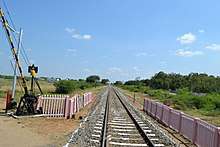
Indonesia
Most level crossings in Indonesia have sirens. They also have two red lights (usually) and full barriers colored red and white. Level crossings in Indonesia are not all officially operated by the Railway Company; some crossings (usually in rural or village areas) are guarded by civilian volunteers, and are not usually guarded 24 hours.[35] Crossings in cities and urban areas are fully operated by the Railway Company. Usually each level crossing has a small guard room to control the traffic and barriers at the crossing. Official crossings are marked by sirens and red-white (Indonesian flag-like) barriers.
Level crossings in Indonesia tend to be congested by traffic, thus they are not automatic like in Western countries, so level crossing watchmen are usually posted at every crossing; these are employees from the Railway Company. However, plan to replace these crossings with automated and also with overpasses arose after the 2013 Bintaro Crash. The Ministry of Transportation bought 11 automated crossing barriers in 2015.[36]
Prior to 2013, there were few major accidents in crossings. On 9 December 2013, a Commuter Line hit a Pertamina fuel truck stuck in Bintaro crossing (now replaced with a flyover), killing drivers (masinis) and passengers in the front car. On 6 December 2015, a Metromini bus was hit by Commuter Line in front of Angke Station, killing 18 passengers of Metromini but doing no damage at all to the train passengers.[37] On 6 April 2018 a Sancaka Train bound for Surabaya hit a container truck near Walikukun Station, Ngawi, killing the train driver.[38]
Due to the high death toll of train versus car accidents and severe traffic jam impact, local and national government have started to close level crossings, especially in Jakarta. Sometimes crossings are closed due to increase of headway, the like Jatinegara-Bekasi track that only leaves 3 from 7 unclosed posts. Numerous underpasses and flyovers have been created, and later the nearby roads are closed; for example, the replacement of 2013 crash site in Bintaro, South Jakarta with a flyover.[39] Crossings in national highways are in the process of permanent closing due to high traffic; for example, the Klonengan crossing in Brebes, located in the main access to Purwokerto city.[40]
Japan
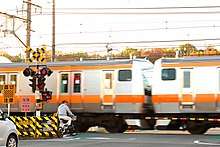
According to the Ministry of Land, Infrastructure, Transport and Tourism, there are in total about 33,300 level crossings (踏切 fumikiri) in Japan as of 2016.[41] These are easily identifiable with their yellow and black crossbucks mounted adjacent to the crossing, and newer crossings are often paved in green asphalt for easy recognition. Most of these are protected with electronic signals (踏切警報機 fumikiri keihouki) usually equipped with alternating flashing red lights and yellow-and-black-striped barriers. Many signals are also equipped with signs with red LED arrows that indicate the direction of approaching trains.
Similarly to school buses in the United States, but unlike many other countries, all cars and bicycles must stop before proceeding over any level crossing in Japan, regardless of whether there are electronic signals, as required by the Road Traffic Act. The only exception is if the crossing is additionally controlled by a traffic light, called a fumikiri shingo (踏切信号); in this case, if the light is green, it is not necessary to stop at the level crossing.[42]
On some busy rail lines, especially in urban areas like in Tokyo, Osaka and Nagoya, so many trains pass through some level crossings that they are almost always closed to vehicular traffic. In some cases, such as the Chūō Main Line, more than 50 trains pass in an hour, which equates to only two minutes in which vehicles can cross the tracks during that interval, causing serious traffic congestion and inconvenience. Many such crossings, known in Japanese as akazu no fumikiri (開かずの踏切), have been eliminated by grade separating rail lines, generally by moving them onto viaducts (高架化) or underground tracks (地下化).
Taiwan
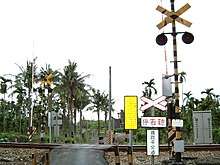
As most railways in Taiwan were built during Japanese administration, railway level crossings remain very common and generally built to the same design as Japan, though many urban crossings have been eliminated when the railroads have been moved underground, e.g. segments of the Western Line in Taipei City, or replaced by viaduct, or abolished, e.g. the former TRA Tamsui Line that is now the Taipei Metro Tamsui Line with no level crossings.
The Act Governing the Punishment of Violation of Road traffic Regulations (道路交通管理處罰條例) prescribes fines for drivers and pedestrians who commit certain classes of violations in regards to level crossings; these include disobeying flagmen, insisting to cross while a crossing's signals are active or when the gate is being lowered, crossing a passive crossing without stopping beforehand, and overtaking, making a U-turn, backing up, stopping or parking on a railway level crossing in a vehicle. Pedestrians can be fined 1,200 new Taiwan dollars for a violation, drivers of non-motorized vehicles such as bicycles can be fined between 1,200 and 2,400 dollars, and drivers of motor vehicles can be fined up to 15,000 to 90,000 new Taiwan dollars for a violation. If an accident occurs, the driver's license can also be revoked for a minimum of six years.
Accidents at railway level crossings remain a very serious concern. The Taiwan Railway Administration alone has hundreds of level crossings along its routes of slightly more than 1,100 kilometres (680 mi). In average, there is a level crossing each 2 kilometres (1.2 mi).[43][44] An emergency button is installed on every level crossing in the country, allowing members of the public to report emergencies at a crossing to authorities, such as stalled vehicles or other obstacles.[45]
Oceania
Australia
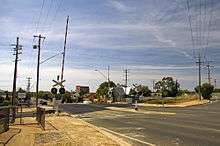
Australian railways generally follow United States practices, and they have increasingly been employing American-made crossing warning equipment, such as level crossing predictors, which are able to provide a consistent amount of warning time for trains of widely varying speeds. There are many different types of rail crossings in Australia; railways that run through rural areas often do not have barriers or even lights/bells to warn of incoming trains, while urban crossings will either have lights and bells or lights, bells, and boom gates.
In Melbourne, there are several level crossings where electrified train tracks cross roads with electrified tram tracks. These crossings are fitted with equipment to change the voltage supplied to the overhead wiring depending on the vehicle using the crossing at that point in time. Trains are severely speed-limited across these intersections. Due partly to this complication, the Victorian Government under Premier Daniel Andrews has begun removing 50 of Melbourne's most dangerous and congested level crossings. This is due to deaths and accidents that have occurred in recent years. The removals are due to complete by 2022.[46]
All cases where a train line crosses a road are classified as level crossings whether or not they are signed. A tram track in its own right-of-way crossing a road can also be classified as a level crossing if it is signed with a crossbuck reading either "TRAM WAY CROSSING" or "RAIL WAY CROSSING". Otherwise, it is considered a regular intersection and usually has either traffic lights or a give way sign facing the road (see Gallery).
Some recent innovations in Australia are to provide crossbucks with a pair of flashing yellow lights at about 200 metres (660 ft) before the level crossing, called Advance Active Warning Signals (AAWS). This is done particularly where there are curves and other visibility problems on the road. AAWS are used where road speeds are high, and braking distances are extended, or where the level crossing is obscured by blind curves or sunlight. Another innovation is to transmit level crossing warning signals by radio into the cabin of nearby vehicles. This would be particularly useful at passive crossings, which are not yet fitted with flashing lights.[47][48]
New Zealand
There are 1390 public road level crossings in New Zealand, of which 275 crossings are protected by flashing red lights, bells, and half-arm barriers; and 421 are protected by flashing red lights and bells only. The remainder are controlled by "Stop and Give Way" signs.[49] Level crossings are the responsibility of rail infrastructure owner KiwiRail Network, the NZ Transport Agency, and if the crossing is on a local road, the local city or district council.
On the Taieri Gorge line and the Hokitika Branch, in rural South Island, New Zealand, roads and railways share the same bridge when crossing a river, with the rail line in the road. Motorists, as well as giving way to oncoming traffic if required (the bridges have one lane) must ensure that the bridge is clear of a train, end to end, before starting to cross the bridge. For safety, trains are limited to 10 km/h (6 mph) while crossing the bridges.
In many parts of New Zealand, railway lines run parallel to and close (within 10–15 metres (33–49 ft)) to roads. Many level crossing accidents have been caused by drivers turning right into side roads crossing the railway line concentrating on finding a suitable gap in oncoming traffic so that they fail to check the railway line or notice the activated level crossing alarms until it is too late to stop. An accident of this type occurred in August 1993 at Rolleston, near Christchurch, when a cement mixer truck turned right off State Highway 1 and collided with the side of a southbound Southerner passenger train, ripping open two carriages. The accident resulted in three deaths, including the sister of New Zealand international cricketer Chris Cairns.
Major accidents
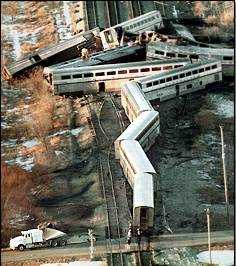
Level crossings present a significant risk of collisions between trains and road vehicles. This list is not a definitive list of the world's worst accidents and the events listed are limited to those where a separate article describes the event in question.
Runway crossings
Aircraft runways sometimes cross roads or rail lines, and require signaling to avoid collisions.
Australia
- Kingsford Smith Airport had a runway crossing, when that runway was extended. The railway was later deviated with sharp curves to avoid that runway.
- Cootamundra West, while not having an actual runway crossing, had extra low signals and telegraph wires at the railway station to improve safety for low flying aircraft landing or taking off.[66]
Gibraltar

Winston Churchill Avenue intersects the runway of Gibraltar International Airport at surface level; movable barricades close when aircraft land or take off.
New Zealand
A level crossing near Gisborne, sees the Palmerston North - Gisborne Line cross one of Gisborne Airport's runways. Aircraft landing on sealed 1310-metre runway 14L/32R are signalled with two red flashing lights on either side of the runway and a horizontal bar of flashing red lights to indicate the runway south of the railway line is closed, and may only land on the 866 metres (2,841 ft) section of the runway north of the railway line. When the full length of the runway is open, a vertical bar of green lights signal to the aircraft, with regular rail signals on either side of the runway indicating trains to stop.[67][68]
Northern Ireland
There was a runway crossing on the Belfast–Derry railway line. The runway was interlocked with conventional railway block instruments to the control tower.
Sweden
The Visby Lärbro Line between Visby and Lärbro crossed the runway of Visby Airport between 1956 and 1960.[69]
See also
References
- 1 2 VicRoads (2014-08-26). "Trains & level crossings". VicRoads. Retrieved 2017-11-12.
- ↑ https://www.admin.ch/opc/fr/classified-compilation/19680245/201612290000/0.741.20.pdf
- 1 2 Cirovic, G.; Pamucar, D. (2012). "Decision support model for prioritizing railway level crossings for safety improvements: Application of the adaptive neuro-fuzzy system". Expert Systems with Applications. doi:10.1016/j.eswa.2012.10.041.
- ↑ Mok, Shannon C; Savage, Ian (1 August 2005). "Why Has Safety Improved at Rail-Highway Grade Crossings?". Risk Analysis. 25 (4): 867–881. doi:10.1111/j.1539-6924.2005.00642.x.
- ↑ Australian Transport Safety Bureau (2004). "Level crossing accident fatalities" Check
|url=value (help). - ↑ Lloyd's Register Rail (2007). "Study of pedestrian behaviour at public railway crossings". Public Transport Safety Victoria. Victoria, Australia.
- ↑ Federal Railroad Administration (2006). "Railroad safety statistics: 2005 annual report". Federal Railroad Administration, Washington D.C.
- ↑ "Honeywell Radar Scanner, Advantages & Benefits" (pdf). Honeywell Regelsysteme GmbH. 11 May 2012. Retrieved 1 September 2013.
- ↑ https://www.transit.dot.gov/sites/fta.dot.gov/files/docs/tsass2003.pdf
- ↑ Section 4D.13 and Section 8D.07 of the Manual on Uniform Traffic Control Devices
- ↑ http://www.era.europa.eu/Document-Register/Documents/Level_crossing_safety_EU_2012.pdf
- ↑ "STT Info - Suomi tasoristeysturvallisuudessa Norjan ja Ruotsin perässä – Euroopan autoilijoita muistutetaan tasoristeysten vaaroista" (in Finnish). STT Info. 24 June 2009. Retrieved 13 September 2017.
- ↑ "Liikennevirasto: Tasoristeykset valtion rataverkolla" (in Finnish). Liikennevirasto.
- ↑ "MTV: Suomi tasoristeysturmissa Pohjoismaiden kärkeä" (in Finnish). MTV Media. 26 June 2007. Retrieved 13 February 2014.
- ↑ "Liikenneturva: Tasoristeyksen ylittäminen" (in Finnish). Liikenneturva. 2013. Retrieved 8 December 2014.
- ↑ Quelques chiffres clés
- ↑ "Accidentologie aux passages à niveau". www.securite-passageaniveau.fr. Retrieved 2016-09-21.
- ↑ Svingheim, Njål (20 January 2009). "Der vei krysser jernbane" (in Norwegian).
- ↑ Olle, Mornell (30 June 2006). "9.4". Kartläggning av plankorsningar (PDF) (in Swedish). Archived from the original (pdf) on 21 May 2013.
- ↑ "Level crossing events – Network Rail". www.networkrail.co.uk. Retrieved 5 October 2018.
- ↑ "Level crossings | Office of Rail and Road". orr.gov.uk. Retrieved 5 October 2018.
- ↑ "Types of level crossings | Office of Rail and Road". orr.gov.uk. Retrieved 5 October 2018.
- ↑ "Level crossings – Network Rail". www.networkrail.co.uk. Retrieved 5 October 2018.
- ↑ https://www.networkrail.co.uk/communities/safety-in-the-community/level-crossing-safety/reducing-risk-level-crossings/. Missing or empty
|title=(help) - ↑ Rivanna Chapter, National Railway Historical Society (2005). "This Month in Railroad History: August". Retrieved 25 August 2006.
- ↑ Federal Highway Administration (2009). Manual on Uniform Traffic Control Devices. Washington, DC: United States Department of Transportation. p. 754. Retrieved 24 September 2013.
- ↑ "Proposed Revision 2009 MUTCD Marked Up to Show Proposed Revisions to Table I-2. Target Compliance Dates Established by the FHWA". Retrieved 28 February 2012.
- ↑ "Old Timey Intersection Railroad Preempts". YouTube. 12 June 2008. Retrieved 30 October 2013.
- ↑ "High-Speed Grade Crossings". Federal Railroad Administration. Archived from the original on 6 March 2012.
- ↑ Mulcahy, John (6 December 2007). "Railroad barrier put to the test". Ann Arbor News. Archived from the original on 2 February 2009. Retrieved 7 December 2007.
- ↑ Helms, Matt (6 December 2007). "Railroad crossing in Wayne Co. to test new technology". Detroit Free Press. Archived from the original on 27 September 2013. Retrieved 7 December 2007.
- ↑ "輕鐵 1013 輕鐵車頭嚴重損毀,司機死亡". 21 November 2008.
- ↑ "Railways to eliminate over 6,000 unmanned level crossings". The Indian Express. 30 July 2016.
- ↑ "Chapter IX- Level crossing and gateman". The Ministry of Railways, Government of India.
- ↑ https://photo.sindonews.com/view/26072/menjaga-perlintasan-kereta-api-tanpa-palang-pintu
- ↑ http://www.beritasatu.com/nasional/320711-kemhub-beli-11-pintu-perlintasan-otomatis-senilai-rp-20-miliar.html
- ↑ https://m.liputan6.com/news/read/2383507/5-fakta-kecelakaan-maut-krl-vs-metro-mini-di-angke
- ↑ https://m.kumparan.com/@kumparannews/ka-sancaka-tabrak-truk-kontainer-di-ngawi-masinis-tewas
- ↑ "1 April, Perlintasan Kerta Api Bintaro Ditutup" (in Indonesian). Metro TV News. 25 March 2017. Retrieved 18 September 2018.
- ↑ https://m.detik.com/news/berita/d-3528441/penampakan-3-flyover-brebes-tegal-solusi-kemacetan-perlintasan-ka
- ↑ "輸送の安全にかかわる施設等に関する事項" (PDF). Ministry of Land, Infrastructure, Transport and Tourism. Archived from the original (PDF) on 24 August 2017. Retrieved 1 July 2017.
- ↑ http://law.jablaw.org/br_railroad
- ↑ "Statistics of level crossings" (PDF) (in Chinese). Taiwan Railway Administration. 2002. Archived from the original (PDF) on 24 August 2006.
- ↑ "Statistics of level crossings" (PDF) (in Chinese). Taiwan Railway Administration. 2005. Archived from the original (PDF) on 24 August 2006.
- ↑ "Level crossing emergency button" (in Chinese). Taiwan Railway Administration.
- ↑ http://levelcrossings.vic.gov.au/crossings
- ↑ "Vic may use radio signals at rail crossings". Australian Broadcasting Corporation. 26 June 2007. Retrieved 30 October 2013.
- ↑ "Post A Comment". Archived from the original on 2 February 2009. Retrieved 6 August 2008.
- ↑ "Level Crossing Safety". KiwiRail. Retrieved 9 February 2012.
- ↑ "India train crash deaths reach 55". BBC. 2005-02-04. Retrieved 2015-06-22.
- ↑ Blair, Edmund (17 November 2012). "UPDATE 5-Train ploughs into school bus in Egypt, 50 killed". Reuters. Thomson Reuters.
- ↑ "Ukraine train and bus collision kills 42". BBC. 12 October 2010.
- ↑ "Slovak bus-rail crash 'kills 11'". BBC. 21 February 2009. Retrieved 21 February 2009.
- ↑ "Al Menos Once Muertos y 228 Heridos en la Mayor Tragedia con Trenes en la Ciudad en Casi 50 Años". Clarín (in Spanish). Buenos Aires. 13 September 2011. Retrieved 23 February 2012.
- ↑ "Argentina Bus and Trains Crash Killing at Least 11". BBC. 14 September 2011. Retrieved 24 February 2012.
- ↑ "Driver Sentenced In Deadly Amtrak Crash". WMAQ TV Chicago. NBC. 28 September 2004. Retrieved 19 January 2006.
- ↑ Ministry of Transport (1968). Report of the Public Inquiry into the Accident at Hixon Level Crossing on January 6, 1968. HMSO. ISBN 0-10-137060-1. Retrieved 24 September 2013.
- ↑ Oake, Dan; Doherty, Ben; Webb, Carolyn; Guerrera, Orietta (5 June 2007). "11 die in train crash". The Age. Fairfax Media. Retrieved 6 June 2007.
- ↑ Simmons, Ann M. (21 August 2008). "Metrolink killer is sentenced to 11 life terms in prison". Los Angeles Times. Tribune Company. Retrieved 21 August 2008.
- ↑ British Railway Disasters. Shepperton: Ian Allan Publishing. 1996. ISBN 0-7110-2470-7.
- ↑ Kerr, Joseph (14 May 2004). "Riding a slow train to nowhere". Sydney Morning Herald. Fairfax Media. Retrieved 11 August 2008.
- ↑ "Driver says light did not turn green - October 27, 1995". CNN. 27 October 1995. Retrieved 19 November 2008.
- ↑ "Metro-North Crash Kills 7 in Worst Accident of Railroad's History - February 3, 2015". New York Times. 3 February 2015. Retrieved 3 February 2015.
- ↑ "Seven train crash dead are named". BBC. 8 November 2004. Archived from the original on 13 June 2006. Retrieved 30 March 2010.
- ↑ "5 dead in Ottawa train-bus collision". CNN International. 2012-09-18. Retrieved 2012-09-18.
- ↑ "Cootamundra West Station". RailCorp.
- ↑ "Gisborne (NZGS) aerodrome diagram" (PDF). Civil Aviation Authority of New Zealand. 24 September 2009. Retrieved 4 January 2010.
- ↑ "Gisborne (NZGS) Operational Signal Lights" (PDF). Civil Aviation Authority of New Zealand. 4 September 2003. Archived from the original (PDF) on 22 May 2010. Retrieved 4 January 2010.
- ↑ "Driftplatser som ingår i bandel 660". Retrieved 19 April 2017.
Bibliography
- Hall, Stanley; van der Mark, Peter. Level Crossings. Shepperton: Ian Allan Publishing. ISBN 978-0-7110-3308-5.
External links
![]()
- Web Accident Prediction System - Highway-rail crossing data from the U.S. Federal Railroad Administration, Office of Safety Analysis
